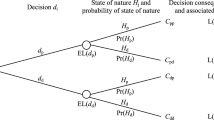Conclusion
What I sought to demonstrate was that the relations between (a) how a case fits into the system, (b) what the main structure of the justification is, and (c) whether discretionary authority is used, are not as simple as suggested in the literature.
What we saw is that if the justification for a decision in a particular case is a practical syllogism with an established legal rule as its major premiss, there are many possibilities: (a) the case did or did not raise a conflict for the judge between his intuitions about reasonableness and his interpretation of the legal system; (b) the case had or had not a clear solution in conformity with the legal system; (c) the case was or was not decided according to what the system seemed to prescribe.
Therefore, the main structure of a justification cannot inform us about questions as: Did the case fit into the system? Is discretionary authority used? The opposition between hard cases and clear cases is much too complex to be of any use to clarify such issues.
Similar content being viewed by others
Author information
Authors and Affiliations
Rights and permissions
About this article
Cite this article
van den Hoven, P.J. Clear cases, do they exist?. Int J Semiot Law 3, 55–63 (1990). https://doi.org/10.1007/BF01130269
Issue Date:
DOI: https://doi.org/10.1007/BF01130269




